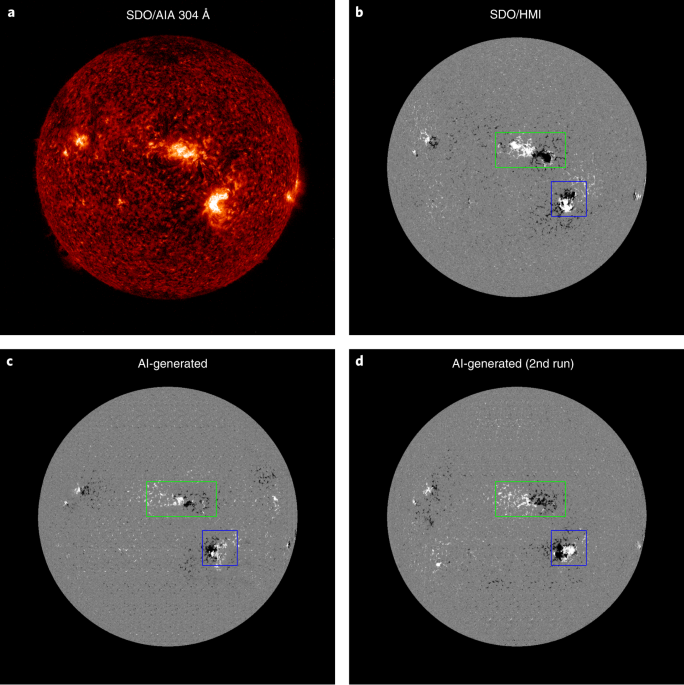
- Select a language for the TTS:
- UK English Female
- UK English Male
- US English Female
- US English Male
- Australian Female
- Australian Male
- Language selected: (auto detect) - EN
Play all audios:
Access through your institution Buy or subscribe arising from T. Kim et al. _Nature Astronomy_ https://doi.org/10.1038/s41550-019-0711-5 (2019) Kim et al.1 proposed an artificial
intelligence (AI) model to predict the photospheric magnetograms of the Sun using extreme ultraviolet (EUV) observations as the only inputs, and concluded that their model is “reliable if
the farside active regions conform to Hale’s law, as long as the slight overestimation of their total flux and a possible slight difference in their tilt angle are considered”. In this
Matters Arising, we present a detailed sensitivity study of the AI algorithm used by Kim et al.1. Despite identifying issues in the data preparation process and the possibility of data
leakage in their work1, we also found the physics basis of this idea problematic. We detail our concerns and analysis below, as well as in the Supplementary Information. This is a preview of
subscription content, access via your institution ACCESS OPTIONS Access through your institution Access Nature and 54 other Nature Portfolio journals Get Nature+, our best-value
online-access subscription $32.99 / 30 days cancel any time Learn more Subscribe to this journal Receive 12 digital issues and online access to articles $119.00 per year only $9.92 per issue
Learn more Buy this article * Purchase on SpringerLink * Instant access to full article PDF Buy now Prices may be subject to local taxes which are calculated during checkout ADDITIONAL
ACCESS OPTIONS: * Log in * Learn about institutional subscriptions * Read our FAQs * Contact customer support DATA AVAILABILITY SDO/AIA and SDO/HMI data are publicly available from NASA’s
SDO website (https://sdo.gsfc.nasa.gov/data/). Details of the dataset we used are available at https://github.com/yiminking/pix2pix_EUV2HMI_datasets. Source data are provided with this
paper. CODE AVAILABILITY Codes for the AI models built in this paper are available at https://github.com/tykimos/SolarMagGAN. Codes used for the detection of active regions are available
upon request from the corresponding author. REFERENCES * Kim, T. et al. Solar farside magnetograms from deep learning analysis of STEREO/EUVI data. _Nat. Astron._ 3, 397–400 (2019). Article
ADS Google Scholar * Camporeale, E. The challenge of machine learning in space weather: nowcasting and forecasting. _Space Weather_ 17, 1166–1207 (2019). Article ADS Google Scholar *
Wang, H. N., Cui, Y. M., Li, R., Zhang, L. Y. & Han, H. Solar flare forecasting model supported with artificial neural network techniques. _Adv. Space Res._ 42, 1464–1468 (2008). Article
ADS Google Scholar * Bobra, M. G. & Couvidat, S. Solar flare prediction using SDO/HMI vector magnetic field data with a machine-learning algorithm. _Astrophys. J._ 798, 135–145
(2015). Article ADS Google Scholar * Korsós, M. B., Ludmány, A., Erdélyi, R. & Baranyi, T. On flare predictability based on sunspot group evolution. _Astrophys. J. Lett._ 802, L21–L26
(2015). Article ADS Google Scholar * Nishizuka, N. et al. Solar flare prediction model with three machine-learning algorithms using ultraviolet brightening and vector magnetograms.
_Astrophys. J._ 835, 156–165 (2017). Article ADS Google Scholar * Liu, C., Deng, N., Wang, J. T. L. & Wang, H. Predicting solar flares using SDO/HMI vector magnetic data products and
the random forest algorithm. _Astrophys. J._ 843, 104–117 (2017). Article ADS Google Scholar * Florios, K. et al. Forecasting solar flares using magnetogram-based predictors and machine
learning. _Sol. Phys._ 293, 28–69 (2018). Article ADS Google Scholar * Huang, X. et al. Deep learning based solar flare forecasting model. I. Results for line-of-sight magnetograms.
_Astrophys. J._ 856, 7–17 (2018). Article ADS Google Scholar * Liu, J., Ye, Y., Shen, C., Wang, Y. & Erdélyi, R. A new tool for CME arrival time prediction using machine learning
algorithms: CAT-PUMA. _Astrophys. J._ 855, 109–118 (2018). Article ADS Google Scholar * Wang, Y., Liu, J., Jiang, Y. & Erdélyi, R. CME arrival time prediction using convolutional
neural network. _Astrophys. J._ 881, 15–24 (2019). Article ADS Google Scholar * Lemen, J. R. et al. The Atmospheric Imaging Assembly (AIA) on the Solar Dynamics Observatory (SDO). _Sol.
Phys._ 275, 17–40 (2012). Article ADS Google Scholar * Scherrer, P. et al. The Helioseismic and Magnetic Imager (HMI) investigation for the Solar Dynamics Observatory (SDO). _Sol. Phys._
275, 207–227 (2012). Article ADS Google Scholar * Arge, C. N. et al. in _Solar Wind 13_ (eds Zank, G. P. et al.) 11–14 (American Institute of Physics, 2013). * Wang, Y. & Zhang, J. A
statistical study of solar active regions that produce extremely fast coronal mass ejections. _Astrophys. J._ 680, 1516–1522 (2008). Article ADS Google Scholar * Zhang, J., Wang, Y. &
Liu, Y. Statistical properties of solar active regions obtained from an automatic detection system and the computational biases. _Astrophys. J. Lett._ 723, 1006–1018 (2010). Article ADS
Google Scholar Download references ACKNOWLEDGEMENTS We acknowledge the use of the data from the SDO, which is the first mission for the NASA’s Living With a Star (LWS) programme. J.L. and
R.E. thank the STFC (UK, grant number ST/M000826/1) and EU H2020 (SOLARNET grant number 158538) for funding. J.L. also acknowledges support from the STFC under grant number ST/P000304/1 and
from the Leverhulme Trust via grant number RPG-2019-371. R.E. also acknowledges the support from the Chinese Academy of Sciences President’s International Fellowship Initiative (PIFI, grant
number 2019VMA0052) and The Royal Society (grant number IE161153). Yimin Wang thanks the Solar Physics and Space Plasma Research Centre (SP2RC), School of Mathematics and Statistics (SoMaS)
at the University of Sheffield for the warm hospitality and support received as an MSRC Visiting Research Fellow while carrying out this research. M.B.K. thanks the STFC for support under
grant number ST/S000518/1. X.H. acknowledges the support from the National Natural Science Foundation of China (grant number 11873060). AUTHOR INFORMATION Author notes * These authors
contributed equally: Jiajia Liu, Yimin Wang. AUTHORS AND AFFILIATIONS * Solar Physics and Space Plasma Research Centre (SP2RC), School of Mathematics and Statistics, University of Sheffield,
Sheffield, UK Jiajia Liu, Yimin Wang & Robert Erdélyi * Astrophysics Research Centre, School of Mathematics and Physics, Queen’s University, Belfast, UK Jiajia Liu * School of
Electrical Engineering, University of Jinan, Jinan, China Yimin Wang * Key Laboratory of Solar Activity, National Astronomical Observatories of Chinese Academy of Sciences, Beijing, China
Xin Huang * Department of Physics, Aberystwyth University, Aberystwyth, UK Marianna B. Korsós * Department of Computer Science, University of Sheffield, Sheffield, UK Ye Jiang * CAS Key
Laboratory of Geospace Environment, Department of Geophysics and Planetary Sciences, University of Science and Technology of China, Hefei, China Yuming Wang * Department of Astronomy, Eötvös
Loránd University, Budapest, Hungary Robert Erdélyi * Gyula Bay Zoltán Solar Observatory (GSO), Hungarian Solar Physics Foundation (HSPF), Gyula, Hungary Robert Erdélyi Authors * Jiajia Liu
View author publications You can also search for this author inPubMed Google Scholar * Yimin Wang View author publications You can also search for this author inPubMed Google Scholar * Xin
Huang View author publications You can also search for this author inPubMed Google Scholar * Marianna B. Korsós View author publications You can also search for this author inPubMed Google
Scholar * Ye Jiang View author publications You can also search for this author inPubMed Google Scholar * Yuming Wang View author publications You can also search for this author inPubMed
Google Scholar * Robert Erdélyi View author publications You can also search for this author inPubMed Google Scholar CONTRIBUTIONS J.L. led and conducted the data preparation and data
analysis and drafted the manuscript. Yimin Wang led and performed the machine learning approach with Y.J. and M.B.K. contributing to the discussions. R.E., X.H. and J.L. recognized the core
problems. R.E. suggested and led the overall research. Yuming Wang helped with the automated detection of active regions. All authors contributed to discussions and participated in the
interpretation of the results. All authors reviewed the manuscript. CORRESPONDING AUTHOR Correspondence to Robert Erdélyi. ETHICS DECLARATIONS COMPETING INTERESTS The authors declare no
competing interests. ADDITIONAL INFORMATION PEER REVIEW INFORMATION _Nature Astronomy_ thanks Nick Arge and the other, anonymous, reviewer(s) for their contribution to the peer review of
this work. PUBLISHER’S NOTE Springer Nature remains neutral with regard to jurisdictional claims in published maps and institutional affiliations. SUPPLEMENTARY INFORMATION SUPPLEMENTARY
INFORMATION Supplementary Discussion, Figs. 1–4 and References 1–13. SOURCE DATA SOURCE DATA FIG. 1 Source data for Fig. 1. Variables can be restored using IDL; use keyword /verb to see
description of variables when restoring. RIGHTS AND PERMISSIONS Reprints and permissions ABOUT THIS ARTICLE CITE THIS ARTICLE Liu, J., Wang, Y., Huang, X. _et al._ Reliability of
AI-generated magnetograms from only EUV images. _Nat Astron_ 5, 108–110 (2021). https://doi.org/10.1038/s41550-021-01310-6 Download citation * Received: 28 April 2020 * Accepted: 14 January
2021 * Published: 12 February 2021 * Issue Date: February 2021 * DOI: https://doi.org/10.1038/s41550-021-01310-6 SHARE THIS ARTICLE Anyone you share the following link with will be able to
read this content: Get shareable link Sorry, a shareable link is not currently available for this article. Copy to clipboard Provided by the Springer Nature SharedIt content-sharing
initiative





